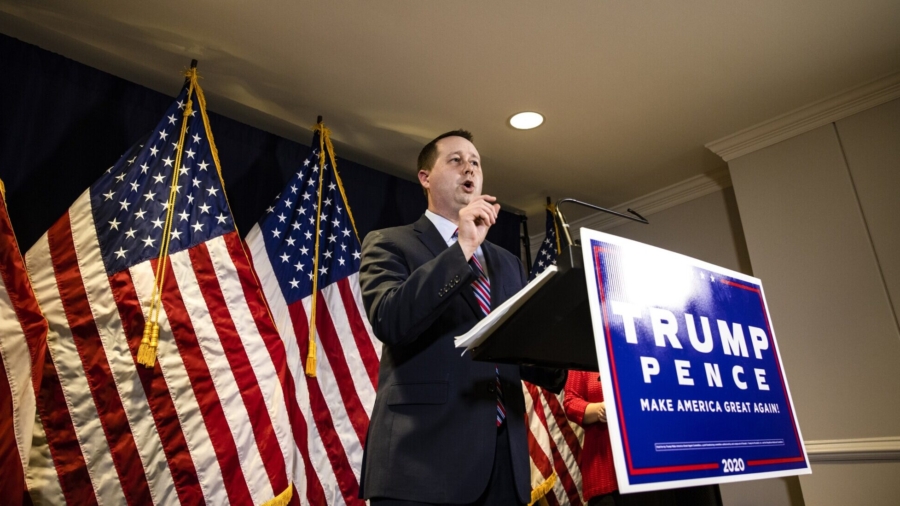WASHINGTON—It’s increasingly likely that the courts will decide the fate of Pennsylvania’s 20 electoral votes, and with that, nudge the eventual presidential winner across the finish line.
On Nov. 9, the Trump campaign filed a lawsuit against Pennsylvania Secretary of State Kathy Boockvar and seven county boards of election—Allegheny, Centre, Chester, Delaware, Philadelphia, Montgomery, and Northampton.
The lawsuit claims that “almost every critical aspect” of Pennsylvania’s Nov. 3 election was “effectively shrouded in secrecy.” It alleges that the Pennsylvania election process violated the Constitution by creating different standards of verification and transparency for mail-in and in-person voters, as well as disparate treatment of Republican and Democrat voters and poll watchers.
“In Philadelphia and Allegheny counties, there were over 682,000 ballots that were tabulated outside the view of our observers who were entitled by law to review those ballots,” Trump campaign legal counsel Matt Morgan said at a press conference on Nov. 9.
Morgan said the Pennsylvania numbers were “very close” to the state’s automatic recount rules, and the lawsuit could “swing that.”
An automatic recount is triggered if the margin of victory is less than or equal to 0.5 percent, but would have to be ordered by the secretary of state no later than 5 p.m. on the second Thursday following the election.
Pennsylvania, like most other states, used widespread mail-in ballots this year, which has long been regarded as the “the largest source of potential voter fraud,” as outlined in the 2005 Carter-Baker Report.
“Vote by mail is, however, likely to increase the risks of fraud and of contested elections in other states, where the population is more mobile, where there is some history of troubled elections, or where the safeguards for ballot integrity are weaker,” the report states.
The U.S. Constitution gives power to state legislatures to decide the “times, places, and manner” of elections. In Pennsylvania, the legislature changed the state’s election code on Oct. 31, 2019, to include the ability to vote by mail without providing a reason or excuse, as was required in the past. It required all votes, including mail-in ballots, to be received by 8 p.m. on Election Day, and that incomplete or improperly filled out ballots must be discarded.
More than 6.7 million votes were cast for president in Pennsylvania, with 2.6 million votes being received by mail.
The Trump campaign lawsuit, filed in U.S. District Court for the Middle District of Pennsylvania, accuses Boockvar of usurping the state’s legislative prerogative to set the election code.
It asks the court to prohibit the certification of the state’s election results if they include the tabulation of absentee and mail-in ballots that don’t comply with the state’s election code. On election night, Trump was ahead by 700,000 votes.
The suit accuses Boockvar and the seven counties of various charges, including:
- Keeping poll watchers from observing the pre-canvass and canvass of mail-in and absentee ballots in several counties, as well as alleged disparities between counties regarding “curing” or correcting improper ballots.
- Contrary to state law, some Democrat-heavy counties contacted voters whose ballots failed to include a signature or weren’t placed into an inner “secrecy” envelope. The voters were able to cast a provisional ballot on election day instead of their initial ballot being deemed invalid and not counted.
- Voters received mail-in ballots—in some cases more than one—despite not applying for them. Election Code requires that a person applying for both an absentee and a mail-in ballot complete and sign an application.
- Voters were visited at home in the weeks before the election by individuals soliciting their participation in mail-in voting.
- Across numerous counties, poll watchers observed poll workers mishandling spoiled mail-in or absentee ballots brought to the polling place by voters who intended to vote in-person.
- Mail carriers noted significant anomalies related to the delivery of mail-in ballots, including multiple instances in which dozens of mail-in ballots were addressed to single addresses, each ballot being in a different name.
- Ballots were mailed to vacant homes, vacation homes, empty lots, and addresses that don’t exist.
- Poll watchers were denied access in some cases, and in others, they were unable to adequately observe the proceedings.
- In Delaware County, observers were denied access to a back-room counting area. After a court-ordered injunction, the poll watchers and canvass representatives were finally allowed in the counting area on Nov. 5 to observe, but for only five minutes every two hours.
The lawsuit said mail-in ballots “inexplicably appeared” in several counties after the required Nov. 4 ballot reports were submitted—including 14,000 in Delaware County alone.
“Plaintiffs have received no explanation for where the additional 14,000 voted ballots came from, when they arrived, or why they are included in the current count,” the lawsuit states.
When asked for a comment about the lawsuit, Boockvar’s office told The Epoch Times, “We do not comment on litigation.”
From The Epoch Times

